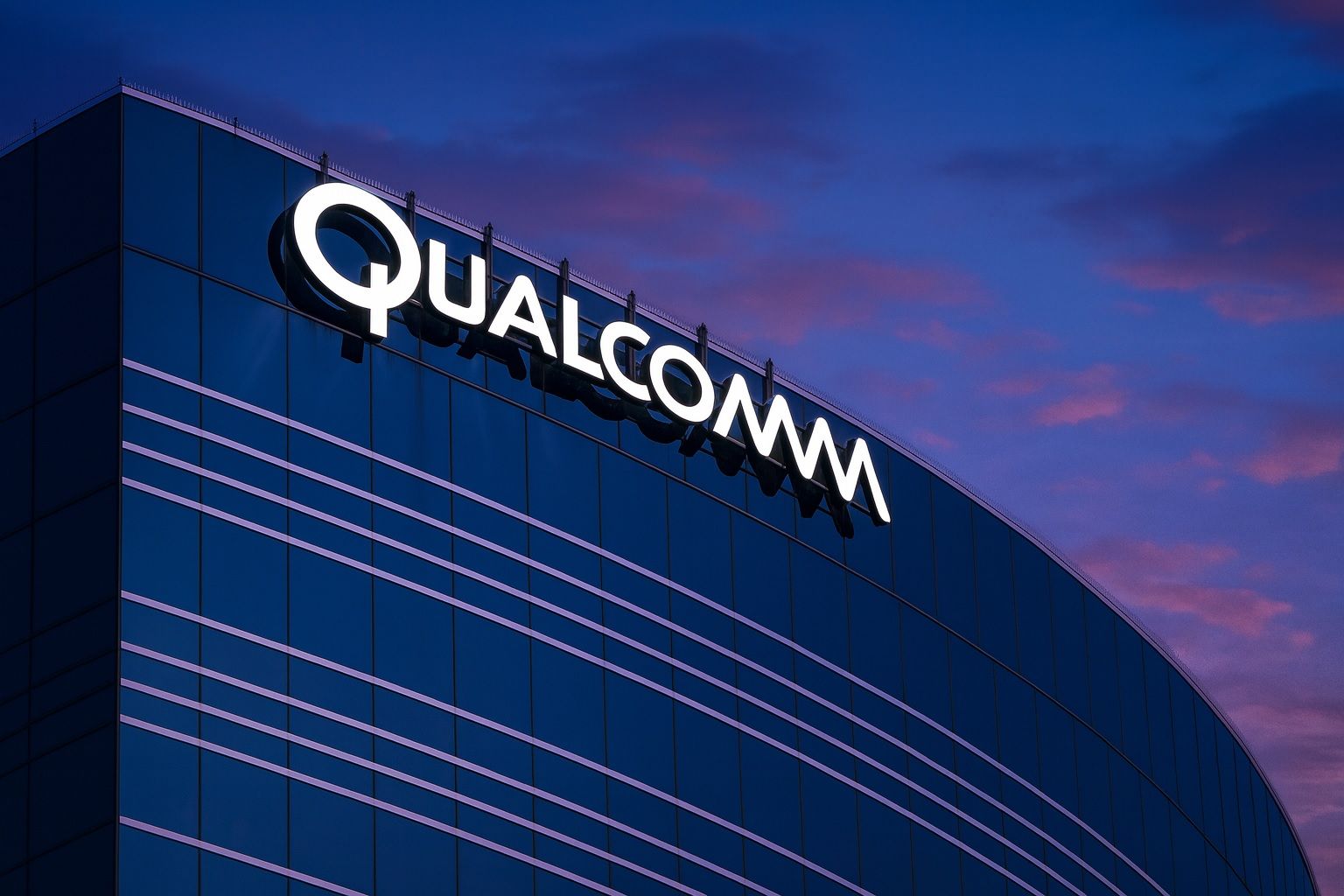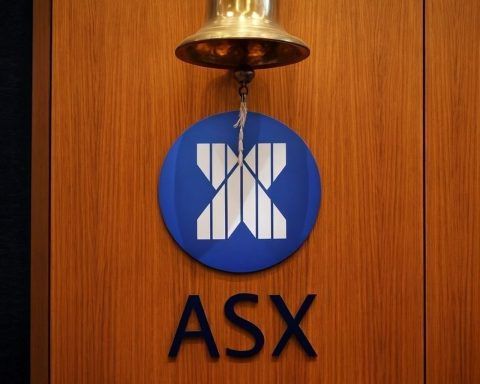What to Know Before Markets Open on October 20, 2025
- Volatile Week Ends Higher: Qualcomm (NASDAQ: QCOM) stock closed around $163.45 on Friday after a roller-coaster week [1]. Shares initially plunged on regulatory fears but rebounded ~6% over five sessions, leaving QCOM roughly flat month-to-date.
- Major News Bombshells: China opened an antitrust probe into Qualcomm’s Autotalks acquisition, briefly knocking the stock down 5% [2]. Meanwhile, Qualcomm scored a legal victory over Arm in a licensing dispute [3] and announced new chips at its Snapdragon Summit – including a mobile processor hailed as the “world’s fastest” and a PC chip beating Apple and Intel in tests [4] [5].
- Earnings & Outlook: Qualcomm last quarter beat estimates (Q3 FY2025 EPS $2.77 vs $2.71 expected) and issued upbeat guidance for Q4 (revenue ~$10.3–11.1 billion, EPS ~$2.75–2.90) [6]. Analysts on average rate QCOM a “Moderate Buy” with a 12-month price target of ~$182 [7] (~12% upside). Bulls cite 5G, AI, and auto-chip growth, while bears warn of fierce competition and Apple’s looming exit from Qualcomm modems [8].
- Market Sentiment Split: Institutional investors have been cautiously trimming exposure (insiders like the CEO sold shares near multi-month highs [9]), yet retail forums buzz with optimism about Qualcomm’s tech leadership. New product launches drew excitement, but geopolitical risks – from China’s scrutiny to U.S.–China trade tensions – temper enthusiasm [10] [11].
- Looking Ahead: With its stock trading at a modest ~15× earnings (well below peers) [12], Qualcomm’s undervaluation vs. rivals like Nvidia and Intel is a key debate. Short-term, all eyes are on upcoming earnings and holiday smartphone sales. Longer-term, Qualcomm is betting on AI-at-the-edge and automotive chips to re-ignite growth even as smartphone demand plateaus.
Stock Price and Recent Performance
QUALCOMM’s stock price has seesawed in mid-October. It closed Friday (Oct 17) at $163.45 [13] per share, down a fraction (-0.4%) on the day after a late-week pullback. This caps a volatile stretch: the stock started the week near $155 after a sharp sell-off, then rallied back roughly +6% by week’s end. Over the past five trading days, QCOM logged solid gains, essentially recovering from the prior Friday’s plunge. Year-to-date the stock is little changed (about flat, and roughly –4% from a year ago [14]), underperforming hotter semiconductor names but reflecting improved sentiment since early 2025’s lows.
Notably, Qualcomm remains well below its 52-week high of ~$182 and far off its all-time peak (~$230 in mid-2024) [15]. The stock’s 52-week range is approximately $121 to $182 [16], illustrating substantial past volatility. At current levels, Qualcomm’s market capitalization stands near $176–178 billion [17]. Its valuation multiples are relatively modest – around 15× trailing earnings (forward P/E ~12–13) [18] – which is low compared to many chip peers. For instance, Nvidia’s forward P/E is roughly 2× Qualcomm’s [19]. This conservative valuation hints that investors remain cautious about Qualcomm’s growth prospects, even as some see a potential value opportunity if growth catalysts materialize.
Major Developments Driving QCOM Stock
China Antitrust Probe & Trade Tensions
The week’s biggest drama came from China’s regulators, who on Oct 10 opened an antitrust investigation into Qualcomm’s recent purchase of Autotalks, an Israeli auto-chip maker [20]. Beijing’s State Administration for Market Regulation is examining whether Qualcomm failed to lawfully declare details of the acquisition, a move that caught investors off guard. The news, coupled with fresh U.S.–China trade saber-rattling (tariff threats from President Trump), sent QCOM shares tumbling over 5% in one day [21]. The stock drop underscored how sensitive Qualcomm is to geopolitical headlines – nearly 46% of its revenue comes from China-based customers [22], so any regulatory roadblocks or sanctions in China pose a direct risk.
Analysts noted the probe could lead to fines or forced remedies, though some saw it as a broader signal amid U.S.–China tech tensions. “With Qualcomm deriving a notable portion of revenue from Chinese handset and automotive customers, this announcement amplifies existing investor caution around geopolitical and regulatory risk,” one analyst observed [23]. Qualcomm had finalized the Autotalks deal in June (after initially indicating it might abandon it) to bolster its automotive vehicle-to-everything (V2X) technology offerings [24]. Now, China’s investigation – coming on the heels of Beijing targeting other U.S. chipmakers like Nvidia – adds to the uncertainty. Qualcomm’s management hasn’t publicly outlined the potential impact, but investors are clearly factoring in a higher risk premium. Fortunately for Qualcomm, the market’s knee-jerk sell-off proved short-lived; by mid-week, bargain hunters stepped in, seeing the drop as perhaps overdone since worst-case outcomes (e.g. deal unwinding or major fines) remain speculative.
Adding to the cloud, Qualcomm is grappling with trade war cross-currents. Washington and Beijing have mostly spared smartphones and mobile chips from tariffs so far [25], and Qualcomm’s products aren’t under current U.S. export bans like advanced AI chips are. But the rhetoric of new tech export controls and tariffs lingers on both sides [26]. Indeed, the October market jitters coincided with reports of potential new U.S. chip restrictions and China’s own crackdown. The broader chip sector has felt these geopolitical tremors – an overhang that could cap near-term upside for stocks like QCOM despite company-specific strengths.
Legal Victories and Challenges
In more positive news, Qualcomm notched a significant legal win in its prolonged battle with British chip IP supplier Arm Ltd. On September 30, a U.S. federal judge issued a “full and final judgment” in Qualcomm’s favor, upholding a jury verdict from late 2024 that Qualcomm did not breach its licensing agreement with Arm [27] [28]. This ruling effectively confirmed Qualcomm’s rights to continue developing custom CPUs (acquired via startup Nuvia) using Arm’s architecture – a major relief for Qualcomm’s plans to compete in high-performance processors. Arm’s request to overturn the verdict was denied, though Arm has said it plans to appeal [29]. For now, Qualcomm is celebrating what it called a “complete victory” and validation that “our right to innovate prevailed”, as its general counsel put it [30]. The stock got a sentiment boost from this outcome, as it removes a legal cloud that had threatened Qualcomm’s foray into PC and server-class chips.
However, Qualcomm’s courtroom battles aren’t over. In early October, a UK court began hearing a £480 million ($647 M) consumer lawsuit filed by the group Which? accusing Qualcomm of anticompetitive practices in mobile chip licensing [31]. The claim alleges Qualcomm abused its dominance to make phonemakers Apple and Samsung pay inflated royalties, indirectly overcharging millions of UK smartphone buyers [32] [33]. Qualcomm is vigorously fighting the case, denying wrongdoing. While the potential fines (if any) are not crippling relative to Qualcomm’s size, the suit exemplifies ongoing global antitrust scrutiny of Qualcomm’s business model (which relies on patent licensing as a profit engine). It’s a reminder that even as Qualcomm wins one legal battle, it faces others on different fronts – from Europe to Asia – keeping its lawyers busy. So far investors seem more focused on the Arm win and immediate business drivers, but the legal/regulatory backdrop remains a mix of wins and challenges heading into 2026.
New Chip Launches and Product News
On the innovation front, Qualcomm made headlines with major product launches that showcase its ambitions beyond mobile handsets. At its annual Snapdragon Summit in late September, the company unveiled the Snapdragon X2 “Elite” and “Elite Extreme” PC processors, its most powerful laptop chips to date. Built on a cutting-edge 3 nm process, the top-tier X2 Elite Extreme packs 18 CPU cores (running up to 5.0 GHz) and an upgraded Adreno GPU, targeting “desktop-class” performance in ultrathin notebooks [34] [35]. Early benchmark tests (from Qualcomm’s own demo units) impressed observers: the X2 Extreme reportedly achieved multi-core scores that beat Apple’s latest M4 chip and doubled the performance of Intel’s fastest mobile CPU in certain tests [36] [37]. Its built-in AI engine also delivered industry-leading results, with Qualcomm claiming the world’s fastest on-device AI processing (an 80 TOPS NPU that outperformed rival silicon in AI vision tasks) [38]. These bold claims – albeit from Qualcomm’s controlled tests – underscore the company’s push into PC computing, a market dominated by Intel, AMD, and Apple. Analysts note that if Qualcomm’s chips can deliver comparable real-world performance with superior power efficiency, it could carve a niche in Windows laptops, especially as Microsoft and PC OEMs seek Arm-based alternatives. It’s a long-term play, but one that has Wall Street intrigued, as success in PCs and AI silicon could open new revenue streams beyond the plateauing smartphone space.
At the same time, Qualcomm is doubling down on its mobile chipset leadership. In early October, it introduced the Snapdragon 8 Elite Gen 5, its latest flagship smartphone System-on-Chip (SoC) for next-generation Android devices. Touted as “the world’s fastest mobile SoC” in Qualcomm’s announcements, the Snapdragon 8 Elite Gen 5 drew substantial buzz in tech circles [39]. The platform promises major performance and efficiency gains and is expected to power premium phones from brands like Samsung, Xiaomi, and OnePlus starting late 2025 [40] [41]. Investor forums lit up with enthusiasm that this chip could bolster Qualcomm’s dominance in high-end Android phones and even enable new PC-like experiences on smartphones [42]. The launch comes as rival chipmakers (e.g. MediaTek) also vie for 5G smartphone market share, so Qualcomm is keen to defend its top-tier status. Early indications suggest strong OEM adoption, which bodes well for Qualcomm’s QCT (chipset) revenues in the coming product cycle.
Beyond core processors, Qualcomm is also expanding into satellite communications and IoT. In mid-October, it announced a collaboration with satellite network operator Iridium to bring satellite connectivity to devices via the Snapdragon Mission Tactical Radio platform for government/military use [43] [44]. And earlier this month Qualcomm made a splash by agreeing to acquire Arduino, the popular open-source electronics platform used by over 33 million developers, in a bid to court the developer community in IoT and edge computing [45] [46]. The Arduino deal (announced Oct 7) gives Qualcomm an inroad to millions of hobbyists and engineers who could build future innovations on Qualcomm’s chips. While terms weren’t disclosed, Qualcomm said Arduino will retain its open, independent identity [47] – signaling Qualcomm’s intent to support a broad ecosystem (even chips from competitors) while subtly steering more projects toward its own silicon. These moves illustrate Qualcomm’s strategy to diversify its business: from smartphone chips into automotive, computing, IoT, and even satellite tech. Each new partnership or product line may only move the needle gradually, but collectively they paint a picture of a company pivoting for the next tech cycle (5G Advanced, AI at the edge, etc.), which investors are watching closely.
Analysts and Experts Weigh In
Wall Street analysts remain cautiously optimistic about Qualcomm, albeit with a keen awareness of its hurdles. About two dozen analysts cover QCOM and the consensus rating is a “Moderate Buy”, skewing toward bullish: roughly 12 Buy recommendations, 10 Holds, and only 1 Sell [48]. The average 12-month price target is ~$182 [49], implying potential upside in the mid-teens percent. Some high-profile optimists go further – for example, J.P. Morgan recently reiterated an Overweight rating and raised its target to $200 [50], citing Qualcomm’s attractive valuation and prospects beyond smartphones. J.P. Morgan analysts noted that Qualcomm is “executing well” across multiple end markets and could surprise investors with strength in areas like automotive and IoT where it has been steadily expanding [51]. The stock’s relatively low multiple (around ~13× forward earnings) is seen as a buffer with upside, assuming earnings can grow in the low double-digits annually as forecast [52].
Not everyone is convinced a breakout is imminent. TD Cowen analysts recently warned that Qualcomm’s growth is facing headwinds, labeling the loss of certain licensing revenues (such as from Huawei, which has been restricted by U.S. sanctions) as “another brick in the wall of worry” for the company [53]. Bears argue that competition is intensifying on all fronts – “Qualcomm faces strong competition, customer attrition, and weak growth projections”, one analysis lamented, suggesting a sustained share price recovery through 2025 may be unlikely [54]. These skeptics point out that Qualcomm’s largest customer, Apple, plans to drop Qualcomm’s modem chips in favor of in-house solutions as soon as 2026, which could erase a lucrative high-margin revenue stream [55]. Furthermore, in the Android arena, MediaTek has been chipping away at mid-tier SoC market share, while in AI and compute, Nvidia and others dominate the data-center side where Qualcomm has little presence. In the PC space, breaking into a Windows ecosystem long-owned by Intel/AMD will be an uphill battle despite Qualcomm’s promising silicon. In short, the bull vs. bear debate revolves around whether Qualcomm’s new bets (AI, autos, PCs) can ramp up fast enough to offset plateauing smartphone sales and potential client losses (like Apple).
To quantify expectations, Wall Street analysts project Qualcomm’s earnings per share will be around $9.4 for FY2025 [56] (which is almost flat vs last year), and they see a return to steadier growth next year if macro conditions improve. The short-term catalyst will be Qualcomm’s next earnings report (expected in early November) where investors will scrutinize holiday-season chip demand and Qualcomm’s commentary on 2026. Any update on Apple (e.g. a possible extension of the iPhone modem supply agreement) or on China (smartphone recovery or further regulatory feedback) could swing the stock.
Market and Investor Sentiment
Investor sentiment around Qualcomm is somewhat mixed, reflecting its transitional moment. Institutional investors – who own about 74% of QCOM’s shares [57] – have been tweaking their positions. Some large funds increased stakes over the summer, seeing value in the beaten-down shares, while others trimmed holdings. For instance, one recent SEC filing showed Mutual of America Capital Management modestly reduced its Qualcomm stake, selling a few thousand shares and valuing its remaining holding at ~$20 million [58] [59]. Such adjustments suggest profit-taking after run-ups, but not a wholesale exodus. In fact, many hedge funds and pensions appear to be in “wait-and-see” mode, maintaining core positions but perhaps not adding aggressively until more clarity on the growth trajectory emerges.
Insiders have made notable moves: CEO Cristiano Amon sold 150,000 shares on Oct 1 at an average ~$165.56 [60] (a ~$24.8 million sale). Other top executives, including the CFO and Chief Accounting Officer, also sold portions of stock over the past quarter [61]. In total, insiders sold ~160,000 shares in the last 90 days [62], and interestingly, there were zero insider buys in that period [63] [64]. While insiders may sell for many reasons (diversification, personal finance, etc.), the sizable CEO sale so close to recent highs drew attention. It led some observers to wonder if management sees the stock as fairly valued near the mid-$160s. Still, insider selling comprises a tiny fraction of outstanding shares, so it hasn’t dramatically altered the investor base – but it does contribute to a cautious undertone.
Meanwhile, retail investor sentiment runs the gamut from bullish excitement to wary caution. On social media platform X (Twitter), discussions about $QCOM spiked following the Snapdragon launches and China news. Quiver Quant’s tracker noted that many retail tech enthusiasts were energized by Qualcomm’s latest chip unveilings, arguing that the Snapdragon 8 Elite Gen 5 and X2 PC chips could “bolster Qualcomm’s dominance” in smartphones and PCs [65]. Some users highlighted the Arm legal win as a confidence booster toward Qualcomm’s strategic pivot into new markets [66]. On the flip side, plenty of voices urged caution: posts have flagged the Chinese antitrust probe and broader geopolitical risks as reasons to temper optimism [67]. The phrase “fluctuating stock price” came up frequently, reflecting how QCOM’s recent dips and pops have made it a hot topic in trading forums. In short, retail sentiment is divided – with a passionate bull camp focused on innovation and undervaluation, and a skeptical camp citing macro and competitive challenges.
Overall, the market mood on Qualcomm can be described as cautiously optimistic. The stock’s relatively low valuation and solid dividend (yielding ~2.2% annually [68]) make it appealing to value-oriented investors, and there’s a sense that Qualcomm’s cash-generative business (over $11 billion in net income over the last year [69]) provides a floor of support. The company continues to return capital to shareholders (it recently hiked its quarterly dividend to $0.89 and conducts buybacks) [70], which investors appreciate in uncertain times. Yet, many are also looking over their shoulder at the broader semiconductor cycle – with smartphone sales only inching up (~1% YoY globally in Q2) [71] and economic crosswinds like high interest rates potentially dampening consumer electronics demand, Qualcomm’s core markets aren’t in high-growth mode. This has kept some investors on the sidelines, awaiting evidence that new areas like automotive, IoT, or AR/VR will meaningfully move the needle for earnings.
Outlook: Can Qualcomm Regain Momentum?
Going forward, the short-term outlook for Qualcomm’s stock will hinge on execution and external conditions in equal measure. In the coming quarter or two, watch for holiday smartphone shipments (a rebound in premium phone demand would directly lift Qualcomm’s chip sales) and China’s economic trends (a recovery in Chinese phone purchases or swift resolution of the Autotalks probe would ease a major overhang). Any update on Qualcomm’s relationship with Apple will be pivotal – notably, Qualcomm has a deal to supply iPhone modems through 2026, but Apple’s progress on its own 5G modem is a wildcard that could dramatically affect 2027 and beyond. Some analysts believe Apple might stick with Qualcomm longer than expected if its internal modem project faces delays, which would be an upside surprise for Qualcomm’s future revenue streams.
In the medium-term (2024–2026), Qualcomm’s bets on 5G, AI, and diversification could start paying off. The global transition to 5G still has room to run, especially in emerging markets, and Qualcomm’s 5G patent licensing ensures it profits broadly as more 5G devices ship. The company’s push into on-device AI – from smartphones that can run advanced AI models to laptops with powerful NPUs – aligns with a tech trend of bringing AI capabilities to the “edge” (as opposed to relying solely on cloud AI). If AI features become a must-have in phones and cars, Qualcomm is positioning itself as a key enabler. In automotive, Qualcomm already has a pipeline of design wins for its Snapdragon Digital Chassis platform (for infotainment, connectivity, ADAS, etc.), and auto-related revenues are growing, albeit from a small base. The Arduino acquisition and other developer-friendly moves hint at an ecosystem play to drive adoption of Qualcomm’s chips in a variety of connected devices – something that could yield an “Apple-like” integration across hardware and software in certain niches over time.
That said, the headwinds are real. Competition will only intensify: MediaTek recently unveiled its own flagship smartphone chip to challenge Snapdragon; Nvidia dominates AI datacenter chips (Qualcomm’s AI efforts are mostly mobile/edge, not directly taking on Nvidia’s turf yet); Intel and AMD are fiercely defending the PC market as Qualcomm encroaches; and new entrants or startups continue to pop up in areas like RISC-V processors that could disrupt the traditional IP model Qualcomm relies on. Geopolitical risk remains a constant backdrop – U.S. export policies, Chinese regulation, and even European Union probes (the EU has fined Qualcomm in the past for competition issues) could surface at any time. These factors might limit Qualcomm’s stock multiple until there’s more certainty.
For investors, Qualcomm offers an interesting risk-reward profile at this juncture. The stock is cheap relative to earnings [72], offers a steady dividend, and the company has a strong balance sheet to invest in new technologies and weather storms. If its gambles in AI processing, PC chips, and automotive electronics bear fruit, Qualcomm could re-accelerate growth and see its share price break out of the recent range – some optimists even argue QCOM could retest its highs above $200 in a bullish scenario of multiple expansion and earnings beats. On the other hand, a pessimistic scenario might see the stock drifting or sagging if smartphone demand stays soft, Apple’s transition hurts revenues, and new ventures don’t ramp up quickly enough.
Bottom line: As of late October 2025, Qualcomm finds itself at a crossroads. The company has navigated immediate shocks – turning a China scare into a mere speed bump – and is armed with cutting-edge products and legal vindication of its strategies. It has momentum in innovation and a proven ability to generate profits. Yet, investors are looking for proof that these positives will translate into sustained revenue and earnings growth in the coming years. The next few quarters (and Qualcomm’s execution of its roadmap) could determine whether QCOM stock remains range-bound or finally ignites into a breakout. For now, Qualcomm appears to be steadily climbing out of its early-October dip, with the stage set for an eventful holiday season and new year. Traders and long-term shareholders alike will be watching closely to see if this tech titan can accelerate into 2026 – or if it will stall out amid the challenges ahead.
Sources: Recent Qualcomm stock and news updates [73] [74] [75] [76], analyst and market commentary [77] [78], Qualcomm investor disclosures and Reuters reports on major developments [79] [80].
References
1. investor.qualcomm.com, 2. www.reuters.com, 3. www.reuters.com, 4. ts2.tech, 5. www.quiverquant.com, 6. ts2.tech, 7. ts2.tech, 8. ts2.tech, 9. www.marketbeat.com, 10. www.quiverquant.com, 11. www.reuters.com, 12. ts2.tech, 13. investor.qualcomm.com, 14. ts2.tech, 15. ts2.tech, 16. ts2.tech, 17. ts2.tech, 18. ts2.tech, 19. ts2.tech, 20. www.reuters.com, 21. www.reuters.com, 22. www.reuters.com, 23. www.reuters.com, 24. www.reuters.com, 25. ts2.tech, 26. ts2.tech, 27. www.reuters.com, 28. www.reuters.com, 29. www.reuters.com, 30. www.reuters.com, 31. www.reuters.com, 32. www.reuters.com, 33. www.reuters.com, 34. ts2.tech, 35. ts2.tech, 36. ts2.tech, 37. ts2.tech, 38. ts2.tech, 39. www.quiverquant.com, 40. 9to5google.com, 41. www.androidauthority.com, 42. www.quiverquant.com, 43. investor.iridium.com, 44. investor.iridium.com, 45. www.reuters.com, 46. www.reuters.com, 47. www.reuters.com, 48. ts2.tech, 49. ts2.tech, 50. ts2.tech, 51. ts2.tech, 52. ts2.tech, 53. ts2.tech, 54. investor.qualcomm.com, 55. ts2.tech, 56. www.marketbeat.com, 57. www.marketbeat.com, 58. www.marketbeat.com, 59. www.marketbeat.com, 60. www.marketbeat.com, 61. www.marketbeat.com, 62. www.marketbeat.com, 63. www.quiverquant.com, 64. www.quiverquant.com, 65. www.quiverquant.com, 66. www.quiverquant.com, 67. www.quiverquant.com, 68. ts2.tech, 69. ts2.tech, 70. ts2.tech, 71. ts2.tech, 72. ts2.tech, 73. ts2.tech, 74. www.reuters.com, 75. www.reuters.com, 76. www.quiverquant.com, 77. ts2.tech, 78. ts2.tech, 79. www.reuters.com, 80. www.reuters.com







